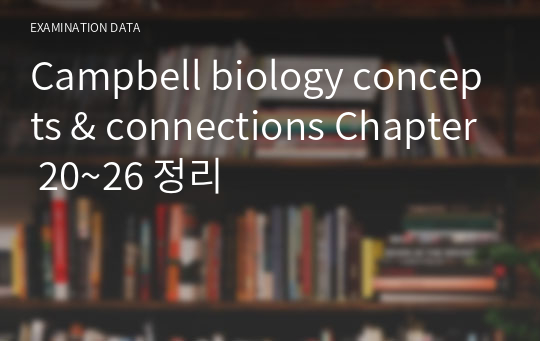Campbell biology concepts & connections Chapter 20~26 정리
12seconds
다운로드
장바구니
소개글
책에 나오는 그림 다 들어가 있음 (그림 설명 요약 포함)줄글 최대한 줄이고 항목으로 만들어서 한눈에 보기 쉽게 해 둠
목차
1. 20. Unifying Concepts of Animal Structure and Function1) 20.1 An Animal’s Form is not the Perfect Design
2) 20.2 Structure Fits Function at all Levels of Organization in the Animal Body
3) 20.3 Tissues are Groups of Cells with a Common Structure & Function
4) 20.4 Epithelial Tissue Covers the Body and Lines Its Organs and Cavities
5) 20.5 Connective Tissues Binds and Supports Other Tissues
6) 20. 6 Muscle Tissue Functions in Movement
7) 20.7 Nervous Tissue Forms a Communication Network
8) 20.8 Organs Are Made up of Tissues
9) 20.9 Bioengineers Are Learning to Produce Organs for Transplant
10) 20.10 Organ Systems Work Together to Perforn Life’s Functions
11) 20.11 The Integumentary System Protects the Body
12) 20.12 Well-designed Experiments Help Answer Scientific Q.
13) 20.13 Structural Adaptations Enhance Exchange with the Environment
14) 20.14 Animals Regulate Their Internal Environment
15) 20.15 Homeostasis Depends on Negative Feedback
2. 21. Nutrition and Digestion
3. 22. Gas Exchange
1) 22.1 Gas Exchange in Humans Involves Breathing, Transport of Gases, and Exchange with Body Cells
2) 22.2 Animals Exchange O₂ and CO₂ across Moist Body Surfaces
3) 22.3 Gills are adapted for Gas Exchange in Aquatic Environments
4) 22.4 The Tracheal System of Insects Provides Direct Exchange between the Air & Body Cells
5) 22.5 The Evolution of Lungs Facilitated the Movememt of Tetrapods onto Land
6) 22.6 In Mammals, Branching Tubes Convey Air to Lungs Located in the Chest Cavity
7) 22.8 Negative Pressure Breathing Ventilates Lungs
8) 22.9 Breathing is Automatically Controlled
9) 22.10 Blood Transports Respiratory Gases
10) 22.11 Hemoglobin Carries 산소, Helps Transport 이산화탄소, and Buffers the Blood
11) 22.12 Human Fetus Exchanges Gases with Mother’s Blood
4. 23. Circulation
1) 23.1 Circulatory Systems Facilitate Exchange with All Body Tissues
2) 23.2 Vertebrate Cardiovascular Systems Reflect Evolution
3) 23.3 Human Cardiovascular System Illustrates the Double Circulation of Mammals
4) 23.4 The Heart Contracts and Relaxes Rhythmically
5) 23.5 SA Node Sets the Tempo of the Heartbeat
6) 23.6 How Should Heart Disease Be Treated?
7) 23.7 Structure of Blood Vessels Fits Their Functions
8) 23.8 Blood Pressure and Velocity Reflect the Structure and Arrangement of Blood Vessels
9) 23.9 Measuring Blood Pressure can Reveal Cardiovascular Pbs
10) 23.10 Arteriole Diameter & Precapillary Sphincters Control the Distribution of Blood
11) 23.11 Capillaries Allow the Transfer of Substances through Their Walls
12) 23.12 Blood Consists of Red/White Blood Cells Suspended in Plasma
13) 23.13 Too Few or Too Many Red Blood Cells can be Unhealthy
14) 23.14 Blood Clots Plug Leaks When Blood Vessels Are Injured
15) 23.15 Stem Cells Offer Potential Cure for Blood Cell Diseases
5. 24. The Immune System
1) 24.1 All Animals Have Innate Immunity
2) 24.2 The Inflammatory Response Disinfects Damaged Tissue
3) 24.3 The Adaptive Immune Response Counters Specific Invaders
4) 24.4 The Lymphatic System Becomes a Crucial Battleground during Infection
5) 24.5 Lymphocytes Mount(시작하다) a Dual Defense
6) 24.6 Antigen Receptors & Antibodies Bind to Specific Regions on an Antigen
7) 24.7 Clonal Selection Mobilizes Defenses against Specific Antigens
8) 24.8 Primary and Secondary Responses Differ in Speed, Strength, and Duration
9) 24.9 Herd Immunity Prevents the Outbreak of Infectious Disease
10) 24.10 Structure of Antibody Matches Its Function
11) 24.11 Scientists Measure Antibody Levels to Look for Waning Immunity after HPV vaccination
12) 24.12 Helper T Cells Stimulate the Humoral and Cell-Mediated Immune Response
13) 24.13 Cytotoxic T Cells Destroy Infected Body Cells
14) 24.14 HIV Destroys Helper T Cells, Compromising the Body’s Defenses
15) 24.15 Rapid Evolution of HIV Complicates AIDS Treatment
16) 24.16 Immune System Depends on Our Molecular Fingerprints
17) 24.17 Immune System Disorders Result from Self-Directed or Underactive Responses
18) 24.18 Allergies Are Overreactions to Certain Environmental Antigens
6. 25. Control of Body Temperature and Water Balance
1) 25.1 Animal’s Regulation of Body Temperature Helps Maintain Homeostasi
2) 25.2 Thermoregulation Involves Adaptations that Balace Heat Gain and Loss
3) 25.3 Coordinated Waves of Movement in Huddles Help Penguins Thermoregulate
4) 25.4 Animals Balance Their Levels of Water and Solutes through Osmoregulation
5) 25.5 Several Ways to Dispose of Nitrogenous Wastes Have Evolved in Animals
6) 25.6 Urinary System Plays Several Major Roles in Homeostasis
7) 25.7 Kidney Is a Water-Conserving Organ
8) 25.8 Hormones Regulate Urinary System
9) 25.9 Kidney Dialysis Can Save Lives
7. 26. Hormones and the Endocrine System
1) 26.1 Chemical and Electrical Signals Coordinate Body Functions
2) 26.2 Hormones Affect Target Cells Using 2 Main Signaling Mechanisms
3) 26.3 Widely Used Weed Killer Demasculinizes Male Frogs
4) 26.4 Vertebrate Endocrine System Consists of More than a Dozen Major Glands
5) 26.5 Hypothalamus, which is closely tied to pituitary, Connects Nervous and Endocrine Systems
6) 26.6 Thyroid Regulates Development and Metabolism
7) 26.7 Gonads Secrete Sex Hormones
8) 26.8 Pancreatic Hormones Regulate Blood Glucose Level
9) 26.9 Diabetes Is a Common Endocrine Disorder
10) 26.10 Adrenal Glands Mobilize Responses to Stress
11) 26.11 Single Hormone Can Perform a Variety of Functions in Different Animals
12) 26.12 Hormones Can Promote Social Behaviors
본문내용
20.1 An Animal’s Form is not the Perfect Design▶ The Giraffe
(1) Long laryngeal nerve: brain→neck→aorta→throat
① 왜 이렇게 길어?: ∵ Evolution- Existing structures arise from previous structures.
(2) Laryngeal nerve 진화 과정(기린 + tetrapods (+humans))
Ex. Analogy – 테이블 위의 전등 & 전기 코드
:신경 끊었다가 다시 이어지는 것보다 전선이 길어지는 게 쉬워
→ The length of the laryngeal nerve in tetrapods must be directly related to the length of the neck.
<중 략>
20.2 Structure Fits Function at all Levels of Organization in the Animal Body
▶ Anatomy
: the study of the form of an organism’s structures
▶ Physiology
: the study of the functions of an organism’s structures
▶ Anatomy VS. Physiology – 기린의 목
(1) Anatomy: focus on the arrangement of muscles and bones in a giraffe’s neck
(2) Physiology: study how a giraffe’s muscle function
(3) 접근법이 다르지만, ‘structure and function’ 기본 원칙
❍ Hierarchical levels of the living world
: molecules → cells → organisms → ecosystems


























